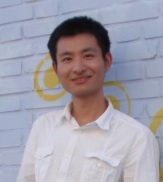
Yu Yusen
PhD Project
Timurid Reception and Integration of Khitā’i Aesthetic: Material, Technique and Image, ca. 1370-1506
Khitā’i is a Persianate indigenous term that addresses things considered from China. My dissertation project examines how Khitā’i aesthetic was entangled in the shaping process of Timurid dynastic visual culture in pre-modern Central Asia and Iran (ca. 1370-1506). This study investigates the Timurid reception and integration of the Khitā’i artistic materials, techniques, images as well as the concomitant styles and forms, which unfolds through the intensive contacts and interaction among Iran, Central Asia and China in the post-Mongol Eurasian framework.
To challenge the previous monolithic definition of “Chinese” influence, I looks at the discursive and aesthetic formation of the Khitā’i idiom in the Timurid context, which dynamically responds to sources of various origins, including the precedent Ilkhanid reworked Chinese motifs, Central Asian nomadic themes, and the newly fabricated visual languages in the contemporary Ming court (1368-1644). Furthermore, adopting a transcultural perspective, this study seeks to go beyond a simple identification of certain “Chinese” characteristics on the Persianate visual productions of certain media; rather, it highlights the role of the Timurid patrons and artists as active agents, and investigates “the processes of interaction that are constitutive of art practice−such as copying, translation, adaptation, reconfiguration, even refusal or resistance” (Juneja). In this sense, this study can hopefully contribute theoretically to the field of Persianate art history.
Throughout the research, I highlight the function of the Timurid princely kitābkhana (workshop) as a generative mechanism, and closely track the impact of the Khitā’i aesthetic on the workshop practices in a micro level, with a focus on the artist`s preparatory sketch assembled and preserved in several albums (muraqqa‘). The study addresses the codification of Khitā’i aesthetic as a process of making, and explores how Khitā’i material, technique and image were produced, preserved, perceived and eventually canonized. It thus extends the understanding of Persianate artistic practice and institution, and uncovers the global dimensions of early modern Persianate art.
Research Interests
• Islamic and Chinese art history
• Persianate arts and architecture in Central Asia, Iran and India (13-19th century)
• Islamic reception of Chinese aesthetics
• "Islamic" arts in China
• The overland Silk Road
Publications
• Books
波斯和中国:帖木儿及其后〔Persia and China: from the Age of Timur Onward〕, Beijing: Commercial Press, 2015 (in Chinese).
• Articles
-"The Arab Empire in Chinese Sources from the 8th Century to the 10th Century ", in Arabia, Greece and Byzantium: Cultural Contacts in Ancient and Medieval Times, ed. Abdulaziz Al-Helabi, Dimitrios G. Letsios, Moshalleh Al-Moraekhi and Abdullah Al-Abduljabbar (Riyadh: King Saud University, 2012), 311-320.
-“从波斯到欧洲:‘中国公主’故事传播的另一个维度〔From Persia to Europe: The Flow of ‘Chinese Princess’ as a Persian Literary Motif〕.” 东方学刊〔Oriental Studies〕 ,v. 2, forthcoming. (in Chinese).
• Conference Papers
-“Animals as Diplomatic Gifts in the Early Modern Eurasia: Practicing Diplomacy of the Timurids”, the CHAM International Conference, FCSH/Universidade NOVA de Lisboa, 15-18 July 2015
-“Khitai: a Persianate Version of Chinoiserie?”, Art Histories and Terminologies II, organized by Forum Transregionale Studien 'Art Histories and Aesthetic Practices', Cluster 'Asia and Europe' and the KHI Florence, Heidelberg, February 6-7, 2015
-“The Heritage of Khwaja Ahrar: Naqshbandis and Chaghatay Rulers in 16th-century Central Asia and Hindustan”, 1st Biennial Graduate Conference on Iranian Studies, St Andrews, 13-14 April, 2013.
